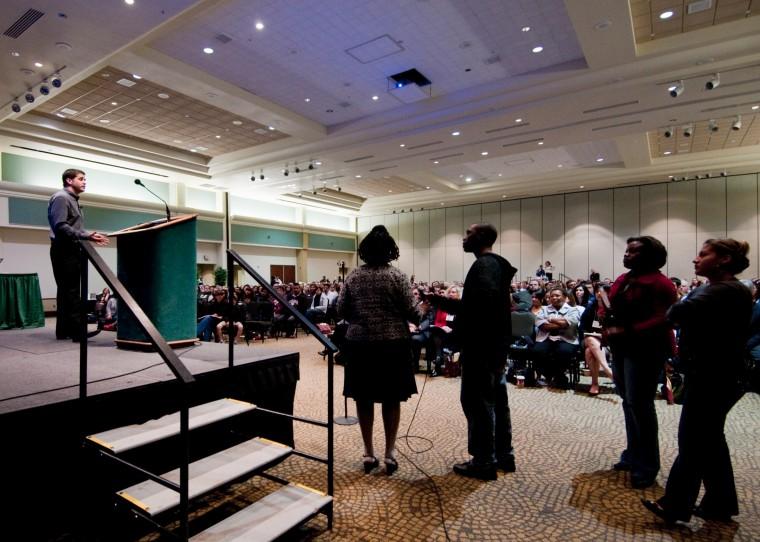Community-focused education encouraged
Brian Schultz, author of “Spectacular Things Happen Along the Way” answered questions posed by the audience after his keynote speech at the 16th annual multicultural education conference in the University Union Ballroom.:
November 21, 2009
Actively involving students and integrating real-life problems into the curriculum is a better way of teaching students, author Brian Schultz said at Saturday’s education conference.
“The notion of bringing real-world problems into the classroom is something that we typically don’t do,” Schultz, the conference keynote speaker, said. “We typically are focused on basal readers and contrived textbook problems.”
The 16th Annual Multicultural Education Conference focused on alternative teaching methods to motivate students in the classroom.
Schultz is the author of “Spectacular Things Happen Along the Way,” and associate chair of the department of education leadership and development at Northeastern Illinois University.
Around 500 people attended, consisting of students, faculty and alumni from Sacramento State and other local colleges, including students from the bilingual and multicultural education department, who also gave presentations.
His teaching style is a complete departure from the traditional curriculum. It involved asking his fifth-grade students at the Richard E. Byrd Community Academy in downtown Chicago what they thought was the biggest problem in their community. Schultz and his students integrated subject areas into the process of solving that problem.
Schultz’s students, all of whom are now in high school, named their dilapidated school building as the biggest problem they wanted to see solved. To integrate writing, for instance, they wrote letters to the media, legislators, concerned citizens and the Chicago Board of Education. “We don’t think you would send your kids to a school that’s falling apart. Why don’t you come see for yourself?” Schultz said was written by his students in letters.
To integrate math, Schultz said students researched statistics and other data and analyzed it.
“We needed to understand what it took to get a new school building,” Schultz said. “We weren’t doing math for math’s sake. We were doing it because it was part of solving a problem.”
Schultz said that this teaching style encouraged students to go to school because the curriculum was about them and their community.
“I didn’t have to fight them to go to school and turn in their work,” Schultz said. “They came to school early, stayed late and came on weekends.”
Although the students didn’t get a new building, several repairs have been done to the school, Schultz said.
To highlight the multicultural aspect of the conference, students presented works of art and some wore traditional clothing that represent their cultures.
A silent auction was held during the conference with proceeds to be used to fund future conferences and the Cesar Chavez scholarship, said science education assistant professor Claudya Lum.
Rae Krasko, single-subject credential program graduate student, said she would apply it to her own teaching strategy. A biology teacher at Roseville High School, Krasko said one way to do this is to create a curriculum focused on the environmental issues that are most important to her students.
Peggy Alexander, Sac State alumna and teacher at John F. Kennedy High School in Sacramento, said that “student-centered, problem-solving curriculum” is applicable to all levels and economic status of students.
“Because it shows that students can collaborate, think critically and can have their curriculum be relevant to present-day problems and to themselves,” Alexander said.












































































































































